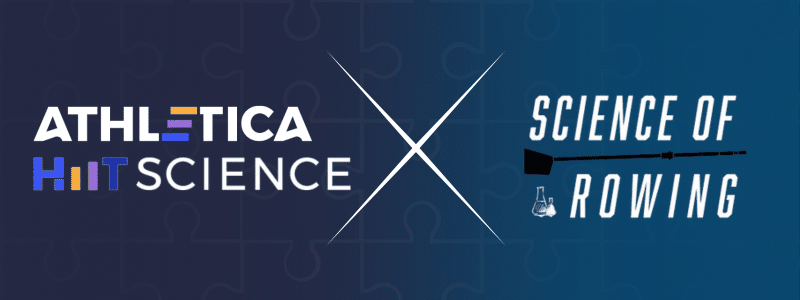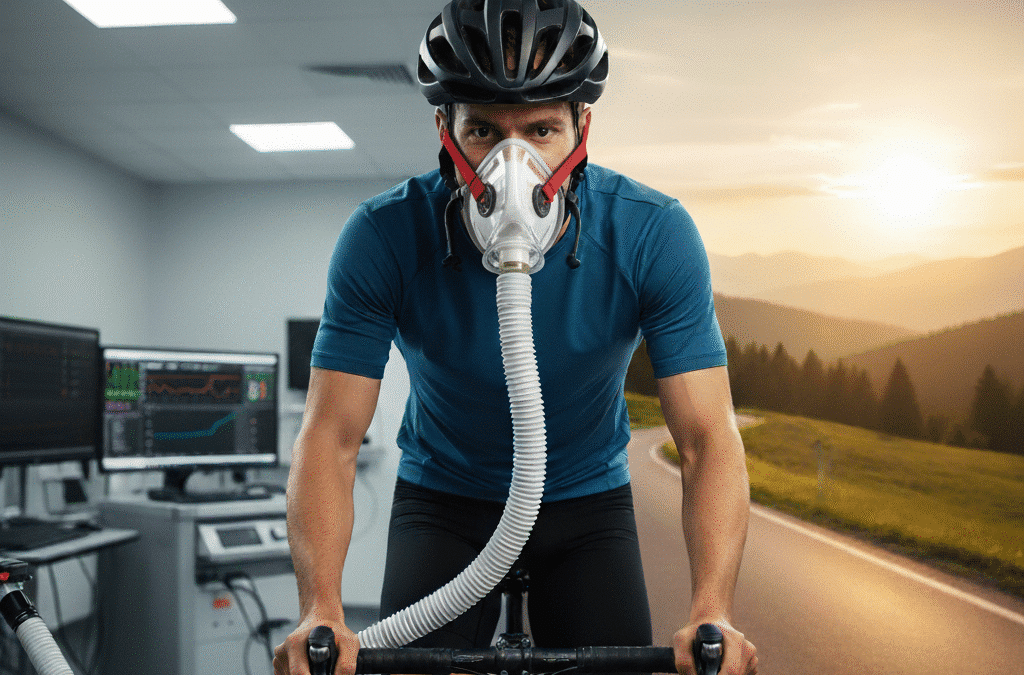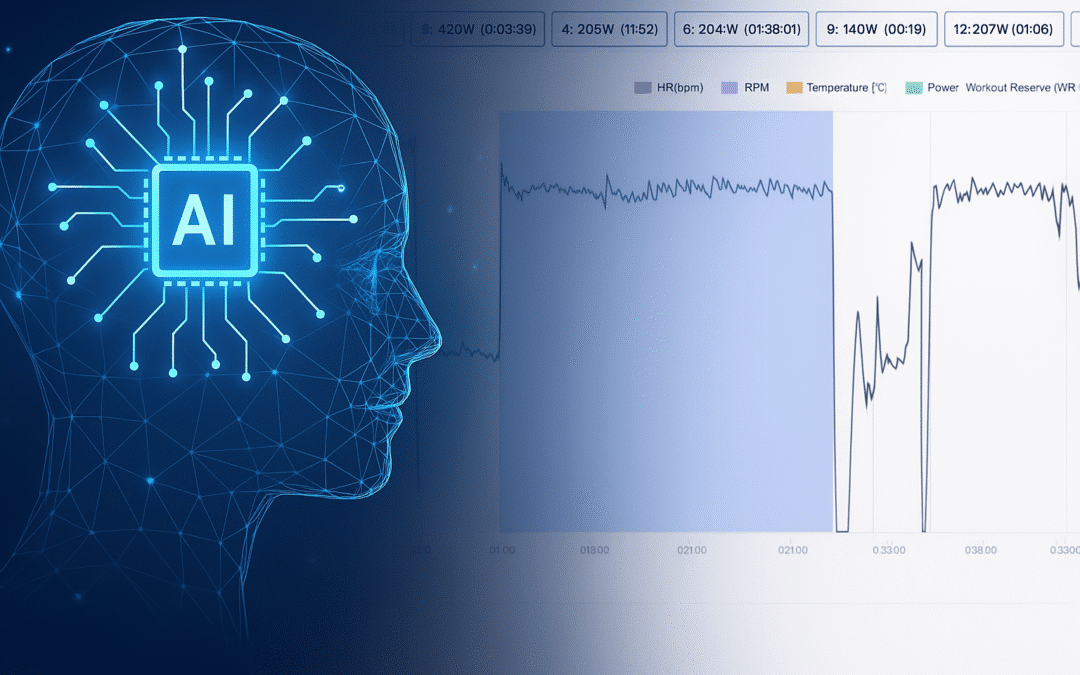Why this guide exists
Rowers keep asking one big question:
“What’s the smartest way to train so I can pull faster splits — without burning out?”
Most Googled answers are static PDF schedules or one‑size‑fits‑all app workouts. Good for a week, useless once life, fatigue, or regatta dates change.
Athletica fixes that problem with an adaptive engine proven in triathlon, cycling, running and HYROX. This guide shows how it works for a rowing training plan, who it helps, and how to start a 14‑day free trial in five minutes.
Who this guide is for
| You are… | Your goal | Skip to |
| Self‑coached indoor rower | Smash a PR on the Concept2 2 k, 5 k or 60‑min | Adaptive engine |
| Masters athlete (40+) | Stay fast & healthy through busy weeks | Masters focus |
| Hybrid / HYROX / CrossFit competitor | Drop split times for race segments | Hybrid athletes |
| Coach | Manage squads with science‑backed individualized plans | Coach dashboard |
Why static plans fail
And why adaptive beats “print‑and‑pin” every time
- Life happens. Miss one session and the weekly structure collapses.
- Recovery isn’t linear. Fatigue, sleep and stress change daily; PDF plans can’t listen.
- No feedback loop. Difficult to know if your prescribed pace was on point or not.
- Age & ability gaps. A 25‑year‑old lightweight and a 55‑year‑old heavyweight need different loads.
Bottom line: you’re running blind; progress stalls, motivation drops and injury risk climbs.
The science: HIIT + Threshold = faster, healthier rowers
Studies show that combining high‑intensity intervals with aerobic base work:
- Increases VO₂ max and threshold power faster than steady‑state alone.
- Triggers similar cardio‑metabolic gains in half the volume.
- Lowers perceived exertion when programmed with adequate recovery.
Athletica’s rowing training plan embeds these findings automatically. You get the evidence-backed dose‑response without necessarily having to read journals.
Webinar replay: The Science of Rowing & Future of AI
Earlier this year Athletica teamed up with USRowing and the Science of Rowing education series to deliver a 70‑minute masterclass on how modern physiology, high‑intensity interval research and AI‑driven analytics are reshaping rowing preparation. The first half, led by PhD candidate Joseph DeLeo, dissects the building blocks of 2 k speed; the second half sees Dr Paul Laursen translate those findings into Athletica’s adaptive engine. If you’d rather watch than read, hit play below. The key timestamps and a searchable transcript sit right under the video for easy reference.
[00:05] Joe DeLeo: “This will be a two‑part presentation. I’ll set the physiological scene, then hand the baton to Dr Paul Laursen.
00:27] Joe — background: Third‑year PhD candidate (University of Kansas), former strength & conditioning coach for Portuguese Rowing Federation, now supporting USRowing para program.
[01:10] Speaker intros: Paul Laursen — ex‑High Performance Sport NZ physiology lead (2009‑2016), co‑author HIIT Science, co‑founder of Athletica.ai.
[02:04] Athletica snapshot: Platform uses AI to individualise endurance plans across running, cycling, triathlon & rowing; adapts as athletes upload new data.
Part 1 · Physiological determinants of 2 000 m rowing (Joe)
- High‑intensity rowing defined: Increase boat speed by raising stroke rate, power per stroke—or both.
- Energy‑system split: 70–77 % aerobic / 23–30 % anaerobic; Joe argues real anaerobic share is “at least 30 %.”
- Force as foundation: Peak on‑water forces for elite M1x start at 1 300–1 500 N; average force scales with boat class.
- Rate of force development: Time‑to‑peak F ~0.36–0.43 s; stroke‑rate specificity matters for transfer.
“Training at 24 spm doesn’t magically convert to 38 spm race cadence.”
Part 2 · HIIT science & AI adaptation (Paul)
[10:30] What is HIIT? Repeated bouts in the red‑zone (≥VT2) with recovery; lets athletes accumulate more high‑intensity volume than continuous work.
- Five HIIT formats: Long intervals, short intervals, repeated sprints, sprint intervals, game‑based sessions.
- Context > content: Session choice must align with athlete phenotype, phase, psychological readiness, event demands.
- Concurrent‑training reminder: Strength work essential; program to minimise neuromuscular interference.
[17:54] Intensity‑control (“Norwegian method”): Precision pacing + lactate caps ensure sustainable adaptation.
[22:10] Lever diagram: Key manipulators — work‑bout intensity/duration, recovery intensity/duration, total reps, modality, nutrition, environment.
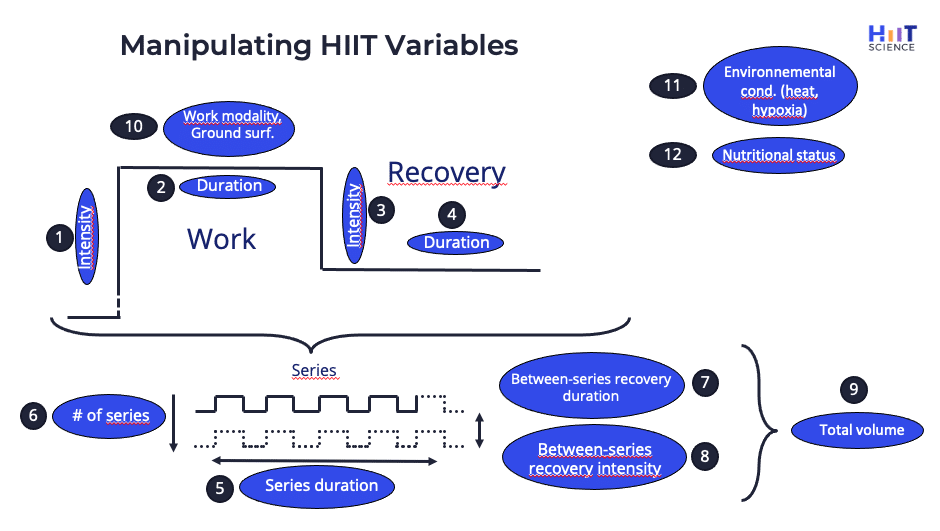
Practical examples
- Long‑interval demo: 4–6 × 3 min @ 95–105 % P/V̇O₂max, 2 min passive rest → maximises VO2 and cardiac output.
- Short‑interval demo: 10 s on/20 s off; HR hits V̇O₂max yet lactate stays low due to rapid myoglobin resaturation. Keeps stress low. Kiwi pair (Bond & Murray) 40 s on/20 s off @ 470 W — showcases anaerobic and neuromuscular load.
Case study · Mahé Drysdale comeback
- Cycling replaced >50 % of weekly load after back injury; HIIT & HRV‑guided training led to 2012 & 2016 Olympic golds.
Athletica demo (Paul)
- Concept2, Garmin & ErgData integrations.
- Critical‑power curve auto‑refresh; zones push into daily sessions.
- Coaches can swap sessions via Workout Wizard; AI monitors HRV + load to prevent overtraining.
Q&A highlights
- Masters programming: Same HIIT principles, lower volume & tighter HRV thresholds.
- Passive vs active recovery: Keep recoveries very easy to maintain low lactate and focus on stroke‑rate specificity.
- Collegiate schedule design: Use winter block for three S&C sessions/wk; shift to maintenance once on‑water volume rises.
- Stroke‑rate strategies: GB emphasises distance‑per‑stroke; Netherlands wins via high‑rate approach (avg 41 spm over 2 k).
Inside the Athletica Adaptive Rowing Training Plan
Automated Zone Detection
Upload your rowing training history (sync your Garmin/Concept2 ErgData) and the platform calculates functional threshold power/pace and heart‑rate zones — no lab visit needed.
Critical Pace & Power Curve
Your curve updates after every row, letting the AI fine‑tune interval targets for 250 m sprints, 2 k race pace, or 30‑min pieces.

AI-Coach Load‑Response Assessment via HRV & Wellness
Morning HR, HRV, sleep hours and RPE feed into the platform’s readiness assessment. A chat‑style AI-Coach then explains your recovery status as shown.

Masters rowers need adaptation, not volume
Peer-reviewed longitudinal data show that VO₂ max declines ≈12 % per decade in sedentary men, but just 5–6 % per decade in endurance-trained masters athletes who continue to train (Rogers et al., 1990, J Appl Physiol). These findings underscore the value of consistent aerobic work and manageable intensity for healthy aging.
Athletica’s adaptive plans are suitable for Masters rowers, as they determine individual readiness for training no matter who you are.
Result: sustainable power progression, fewer niggles, and consistent training enjoyment.
Technique & Stroke‑Rate Optimisation
A fast split is meaningless if every stroke leaks watts. Two mechanical levers drive boat speed:
- Stroke rate (cadence, spm) – how often you apply force.
- Distance‑per‑stroke – how far the boat travels each pull.
Elite crews optimise the product of the two, not just one or the other. Most club rowers, however, spend >80 % of training below 26 spm and then “shock” the system at 36 spm on race day. The result: blown legs and sloppy catches.
The sweet‑spot bands
| Intensity band | Typical spm | Target split cue |
| UT2 steady | 18–22 | “Should feel conversational” |
| UT1 / aerobic power | 22–26 | –6 to –12 s vs 2 k split |
| Threshold | 26–30 | –4 to –6 s vs 2 k split |
| Race‑specific | 32–38 | Goal 2 k split or faster |
How Athletica coaches stroke rate
- Session prescriptions include both zone and stroke rate targets: e.g., “4 × 8′ @ UT2, 26 spm”.
- Post‑row feedback analyses power × spm scatter to flag inefficient strokes.
Dialling in the right training zone in line with your stroke rate during every phase of training means your race‑day jump to 34–38 spm feels rehearsed, not risky.

Hybrid athletes: row faster splits without extra volume
HYROX and CrossFit demand a 1 000 m or 500 m blast inside multi‑modal events. The adaptive plan slots rowing HIIT around running, sled pushes and strength so you hit race day fresh.
Example HYROX workout:
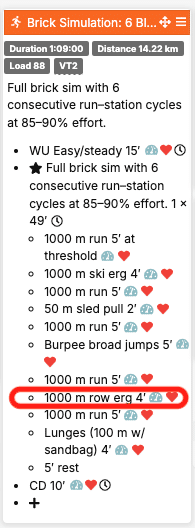
For coaches: scalable programming
- Let Athletica do your individual programming.
- Customise your sessions.
- Monitor HR, HRV and compliance in one dashboard.
- Communicate seamlessly with your athletes.
No more spreadsheet chaos.

Case study: Martino Goretti’s use as coach
With Athletica’s rowing training plans, Martino finds the right balance between structure and flexibility:
- “The base structure is there — the AI gives me a reliable plan to work from.”
- “But I can still add my own coaching insights based on how my athletes move, feel and respond.”
The adaptive platform has made his job easier by centralizing performance data, monitoring HRV, and offering session tweaks based on recovery. It’s not just a tool for elite athletes — Martino views Athletica as a coach’s assistant, a resource for learning and a way to deliver high-quality training to more people.
Sneak‑peek rowing training plan preview
Just one example of a recovery training week for a low volume rower is below. Choose from hundreds of different options within Athletica based on your individual training needs.

How to get started today
- Create your free Athletica account → Start trial
- Choose “Rowing” during onboarding.
- Link you Concept2, Garmin Connect, Wahoo, intervals.icu or Strava accounts.
- Watch your personalised plan populate — adapt as life happens.
Frequently asked questions
- What equipment do I need?
Any Concept2, RP3, Hydrow or on‑water setup plus a heart‑rate strap connected to Garmin Connect or Strava. - How many rowing sessions per week do I need to improve?
Athletica’s rowing training plan adapts to your schedule and fitness and programs accordingly to hit your sweet spot between daily availability and physical ability. - How often should I test my 2 k?
Most athletes re-test after every key build. Athletica schedules a simulation automatically at the beginning of each training block. - Can I mix in running, cycling or swimming?
Yes — our multi‑sport platform means the engine blends loads across sports. - Is the plan suitable for beginners?
Absolutely. Choose the Beginner track — the first two weeks focus on technique, rhythm, and low-rate aerobic rows. - How accurate is the zone detection?
Within ±3 % of lab-tested lactate threshold in validation trials. - Do I need on-water data, or is erg-only OK?
Erg-only is fine. Upload on-water GPS files when available for even better load precision. - Is there a coach discount?
Yes — teams of five or more athletes receive substantial discounts. Contact support for details.
Resources & further reading
- HIIT Science: Optimal recovery duration for rowing intervals
- Rowing secrets with Martino Goretti
- USRowing x Science of Rowing webinar replay
Ready to pull your best split yet?
Click Start My Adaptive Rowing Plan and see the difference in your very next session.

